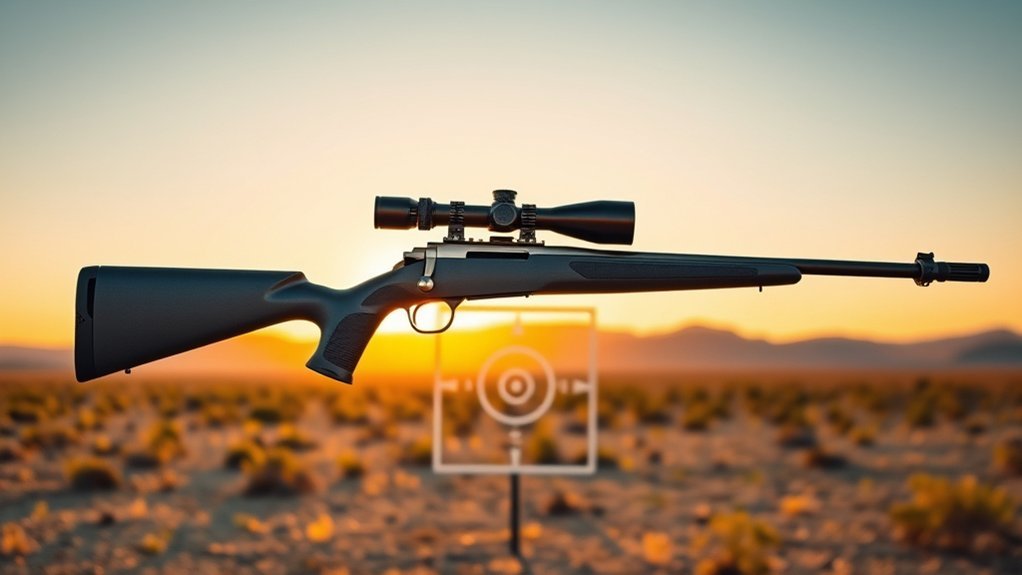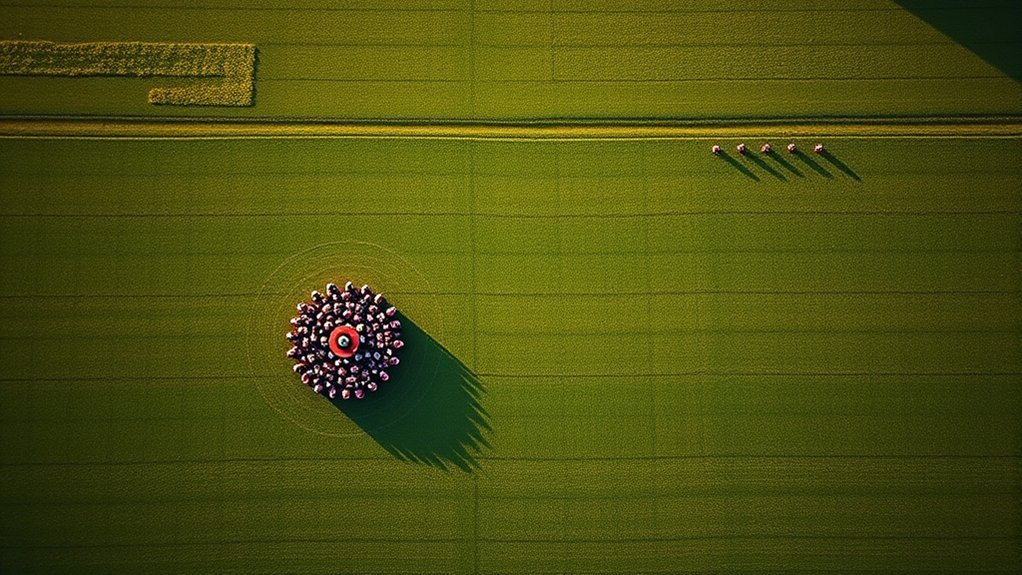Did you know that a bullet’s maximum range can exceed several miles, depending on the type of firearm? However, hitting a target accurately requires understanding effective range, which varies considerably due to factors like bullet design and environmental conditions. As you consider the implications of these two concepts, you’ll find that they play critical roles in both shooting performance and tactical decision-making. What does this mean for your shooting practices?
Understanding Maximum Range

When you think about maximum range, it’s essential to understand that it represents the farthest distance a projectile can travel under ideal conditions. This distance is influenced by various factors, including launch angle, initial velocity, and environmental conditions. Typically, a 45-degree angle yields the best trajectory, maximizing horizontal distance. The calculations involve using physics principles, particularly the equations of motion and gravitational effects. You’ll notice that maximum range assumes no air resistance or other external forces, which isn’t realistic in practical scenarios. Consequently, while it’s a useful theoretical concept, it doesn’t directly translate to real-world applications. Understanding maximum range provides a foundation for further exploration into projectile motion, enabling you to appreciate the intricacies of effective range in practical use.
Understanding Effective Range

Effective range refers to the distance at which your firearm can accurately and reliably hit a target. Various factors, such as bullet type, environmental conditions, and shooter skill, greatly influence this performance metric. Understanding effective range is essential for practical applications in shooting, as it directly impacts your ability to make precise shots under varying circumstances.
Defining Effective Range
Understanding effective range is essential for anyone looking to maximize shooting performance. Effective range refers to the distance at which a shooter can consistently hit a target with acceptable accuracy and precision. This range isn’t merely about how far a projectile can travel; it considers factors like bullet drop, wind drift, and target size. To define your effective range, assess your equipment, ammunition, and personal shooting skills. You must practice under various conditions to determine the limits of your accuracy. Typically, effective range is shorter than maximum range, as it emphasizes not just hitting the target, but doing so reliably. Consequently, knowing your effective range helps you make informed decisions during shooting activities, ensuring peak performance.
Factors Influencing Performance
Several factors influence your shooting performance and, consequently, your effective range. First, bullet trajectory plays an essential role; understanding how gravity and air resistance affect your shot can enhance accuracy. Second, environmental conditions, such as wind speed and direction, can greatly alter a projectile’s path, necessitating adjustments in your aim. Third, your shooting technique, including stance, grip, and follow-through, directly impacts consistency and precision. Additionally, the firearm’s characteristics—such as barrel length, caliber, and sighting system—affect effective range. Finally, your physical and mental state can influence focus and control, impacting performance under pressure. By evaluating these factors, you can better understand and optimize your effective range for more accurate shooting outcomes.
Practical Applications in Shooting
When engaging in shooting, knowing your effective range is essential for achieving accurate hits on target. This practical knowledge helps you select the right ammunition and equipment while optimizing your shooting technique. Understanding effective range allows you to make informed decisions about engagement distance, enhancing your performance.
Here’s a quick reference table to illustrate effective range considerations:
| Factor | Description | Impact on Effective Range |
|---|---|---|
| Bullet Type | Weight and design | Affects trajectory and stability |
| Environmental Conditions | Wind, humidity, temperature | Influences bullet drop and drift |
| Shooter Skill Level | Experience and technique | Determines hit accuracy |
| Firearm Specifications | Barrel length, caliber | Impacts velocity and energy |
Factors Affecting Maximum Range

While various factors contribute to the maximum range of a projectile, key elements such as launch angle, initial velocity, and environmental conditions play pivotal roles. The launch angle determines the trajectory; typically, angles around 45 degrees yield ideal distance. Initial velocity directly influences how fast the projectile travels, with greater speeds extending range considerably. Environmental conditions, including air density, temperature, and wind, also affect performance. For instance, higher altitudes reduce air resistance, enhancing range. Conversely, crosswinds can alter the projectile’s path, potentially diminishing its distance. Understanding these factors allows you to maximize the effectiveness of your shots, ensuring that you can achieve the greatest possible range under varying circumstances. Hence, meticulous consideration of these elements is essential for ideal projectile performance.
Factors Affecting Effective Range
Understanding the factors that affect effective range is essential for optimizing performance in both tactical and recreational shooting scenarios. Key elements include bullet design, caliber, and muzzle velocity. The bullet’s construction influences its terminal performance, impacting how energy is transferred to the target. Caliber affects both the ballistic trajectory and the wind resistance, which can alter the bullet’s path. Muzzle velocity plays a vital role too; higher velocities typically lead to flatter trajectories. Additionally, environmental conditions, such as wind, humidity, and temperature, can greatly affect bullet flight. Finally, the shooter’s skill level, including their ability to control breathing and trigger pull, directly impacts effective range. By analyzing these factors, you can enhance your shooting proficiency and decision-making in the field.
The Importance of Accuracy
Accuracy plays a pivotal role in achieving effective range, as it directly determines your ability to hit a target reliably. Without precision, even the most powerful firearm won’t serve its purpose. Factors like sight alignment, trigger control, and environmental conditions greatly impact accuracy. Each shot you take must account for these variables; neglecting them can result in missed targets, regardless of distance. In addition, consistent practice enhances your muscle memory, allowing you to make precise adjustments in response to external influences. This continuous improvement not only boosts your confidence but also maximizes the effective range of your weapon. Ultimately, honing your accuracy is essential for ensuring that your shots land where you intend, thereby optimizing your overall shooting performance.
Practical Applications in Shooting
When you apply the concepts of effective range and maximum range in practical shooting scenarios, you enhance your overall performance and decision-making. Understanding these ranges allows you to make informed choices, ensuring you hit your target accurately and efficiently. Here are four practical applications to reflect upon:
- Target Identification: Recognize the distance to your target to select the appropriate range for your shot.
- Zeroing Your Firearm: Adjust your sights based on the effective range for improved accuracy.
- Wind and Environmental Factors: Evaluate how these elements affect your shot within the effective range.
- Ammunition Selection: Choose the right ammunition based on its performance at varying ranges.
Differences in Firearm Types
While various firearm types serve different purposes, their effective and maximum ranges can differ markedly based on design and intended use. For instance, rifles typically have longer effective ranges due to their rifled barrels, which stabilize the bullet’s flight, making them suitable for long-distance shooting. Shotguns, on the other hand, excel in close-range scenarios, as their spread pattern decreases accuracy over longer distances. Handguns offer versatility, but their effective range is generally shorter due to barrel length and sight radius. Each firearm type’s mechanics, such as caliber, barrel length, and ammunition type, directly influence performance. Understanding these differences is essential for selecting the right firearm for specific shooting needs, whether for sport, defense, or hunting.
Real-World Examples
Understanding real-world examples of effective versus maximum range can help you appreciate how these concepts apply in practical scenarios. Here are some key instances to take into account:
- Rifles: A .308 Winchester may have a maximum range of 1,000 yards, but its effective range is typically around 800 yards for precision shooting.
- Shotguns: A 12-gauge shotgun may have a maximum range of 400 yards, yet its effective range for bird hunting is usually limited to 30 yards.
- Handguns: A 9mm pistol’s maximum range might extend to 200 yards, but its effective range is often confined to 50 yards for accurate engagement.
- Archery: A modern compound bow can shoot up to 300 yards, but its effective range for hunting is generally around 40 yards.
These examples illustrate the importance of understanding both ranges in various contexts.
Tips for Improving Effective Range
To enhance your effective range, focus on optimizing your shooting technique; this includes stance, grip, and trigger control. Additionally, using quality ammunition can greatly improve consistency and accuracy. By refining these aspects, you’ll maximize your performance in the field.
Optimize Shooting Technique
Mastering your shooting technique is essential for optimizing your effective range. To enhance your precision and control, focus on the following critical elements:
- Stance: Maintain a stable, balanced position. Your feet should be shoulder-width apart, with weight distributed evenly.
- Grip: Apply a firm grip on your firearm, ensuring your hands align correctly to minimize recoil.
- Sight Alignment: Keep your sights aligned consistently with your target. Practice focusing on the front sight for improved accuracy.
- Trigger Control: Squeeze the trigger smoothly without jerking. This prevents unnecessary movement that can throw off your aim.
Use Quality Ammunition
Quality ammunition plays an essential role in extending your effective range and enhancing overall performance. When you choose high-grade cartridges, you guarantee consistent velocity, accuracy, and terminal ballistics. Look for ammunition that matches your rifle’s specifications; this includes bullet weight, type, and powder charge. Precision-engineered rounds minimize variability, reducing the impact of environmental factors like wind and humidity.
Additionally, pay attention to the bullet design; for example, match-grade bullets can improve group sizes greatly at extended distances. It’s also wise to test various brands and loads to identify which performs best with your firearm. By investing in quality ammunition, you maximize your shooting capabilities, enabling you to hit targets accurately at longer ranges with confidence.
Safety Considerations in Shooting Practices
While understanding the concepts of effective range and maximum range is essential, safety considerations in shooting practices are paramount and cannot be overlooked. Adhering to safety protocols not only protects you but also those around you. Here are four critical safety considerations:
Safety in shooting practices is crucial; always prioritize protocols to ensure the well-being of yourself and those around you.
- Always treat every firearm as if it’s loaded. This fundamental rule helps prevent accidental discharges.
- Ensure a proper backstop. Confirm that your intended target area is safe and free of obstacles.
- Wear appropriate safety gear. Eye and ear protection can prevent serious injuries.
- Follow range rules diligently. Abide by all posted regulations and instructions from range officers to maintain a safe environment.
Conclusion
In mastering the balance between effective range and maximum range, you’re like an archer honing your aim for the bullseye. While the allure of distance may dazzle, remember that true skill lies in consistent accuracy. By understanding the nuances that influence these ranges, you can elevate your shooting proficiency. So, as you practice, think of each shot as a brushstroke in a masterpiece—precision is key to crafting your own success story in marksmanship.

